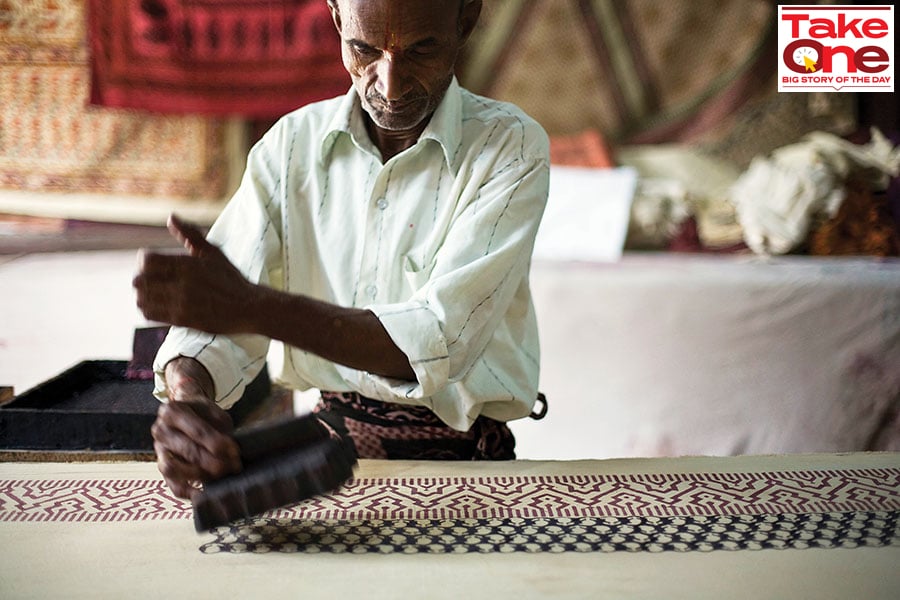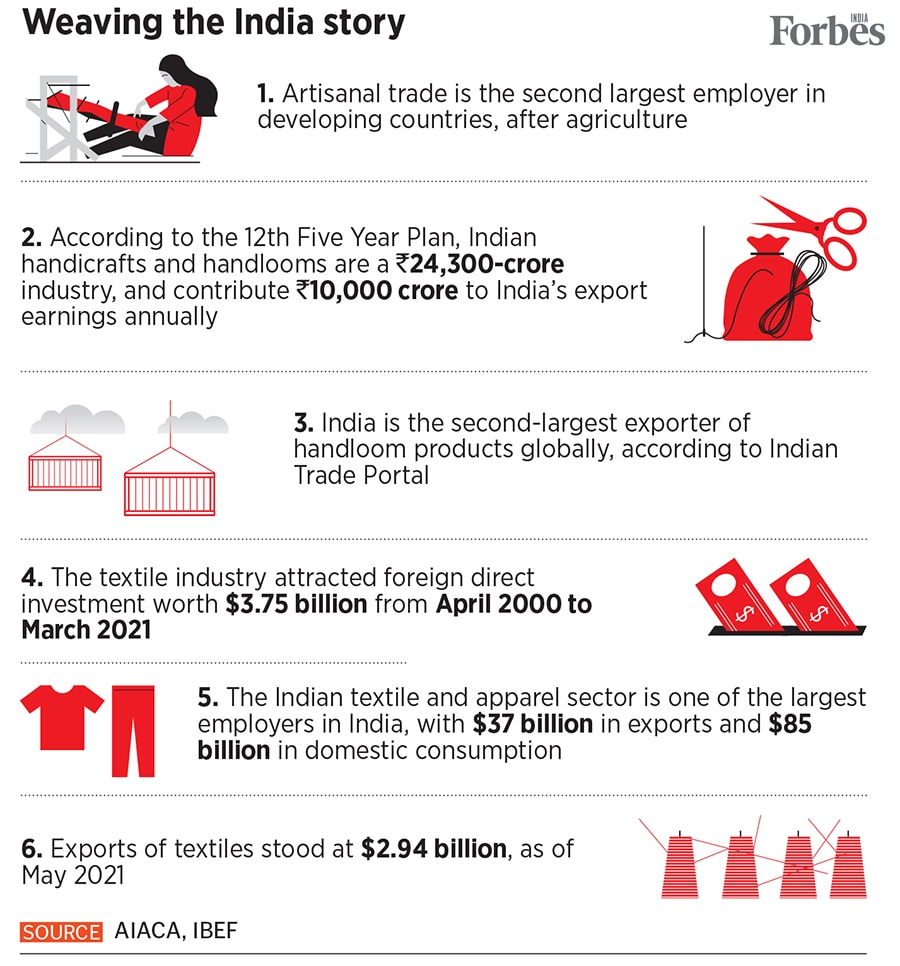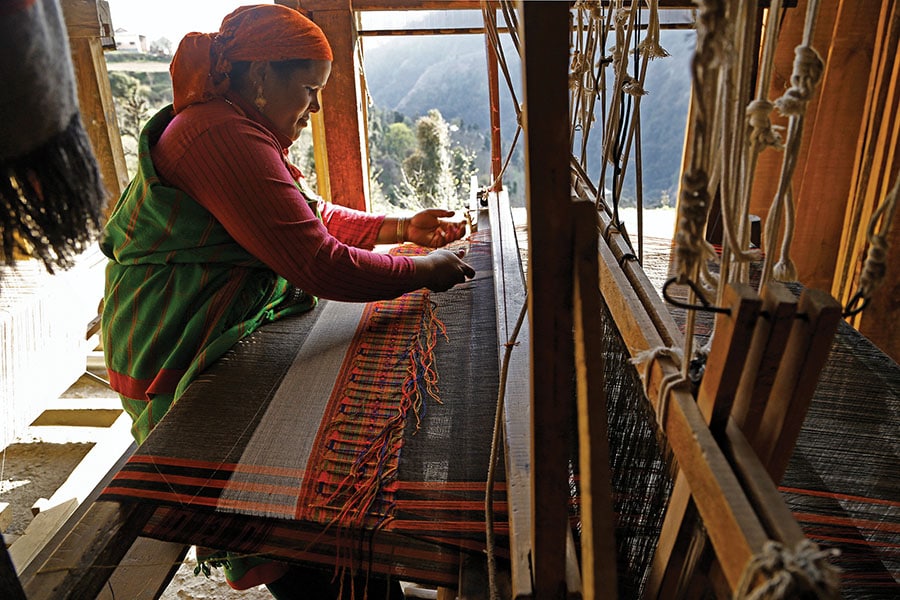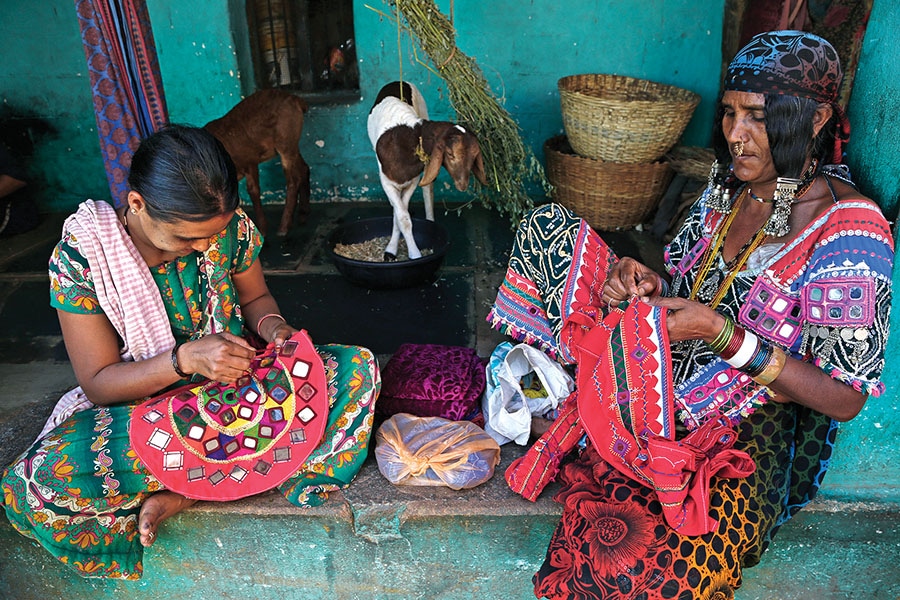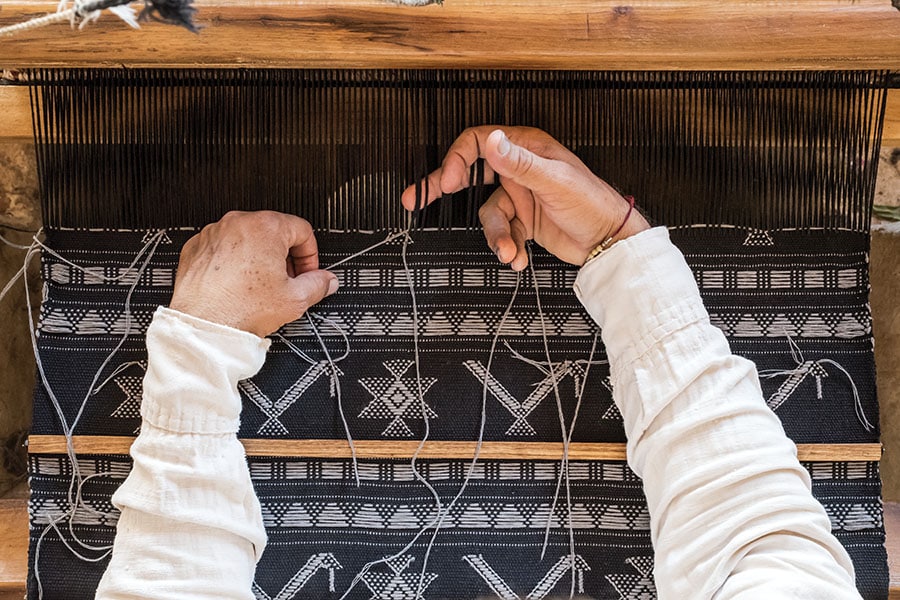In the middle of August, a version of these block prints found new life in a collection that sold from Sweden to Japan, and indeed, broke the internet—yes, it sold out within minutes, but also polarised sections of its home country, India.
With a much-coveted Bengal Tiger logo across everything from T-shirts to sarees, the collection was a collaboration between Swedish fast fashion brand H&M, and India’s maharaja of ornate bridal wear, Sabyasachi Mukherjee, the man behind the eponymous label. In its top 10 markets (including the US, Germany, the UK, Russia, Sweden, China and other European countries) alone, H&M has a total of 4,913 stores, and e-stores in 53 countries. A Sabyasachi lehenga, on the other hand, is a purchase of pride, a once-in-a-generation investment for many. Where do the twain meet?
“From day 1, we knew the collaboration would be global, and I was keen to maintain a strong visual identity of India. The best way to do that was with prints, which are iconic, and prints that have been part of our heritage and history—something that is easily recognisable as Indian," says Mukherjee.
“It was a tough battle," he adds. “The collection would sell in India, and also in Japan, Sweden, Italy, France—very different markets with different tastes. I had to create something that would travel across geographies, yet something that was iconic, and would shed the ‘costumey’ image of Indian fashion."
Commercially, the online-exclusive collection—the first of its kind for an Indian designer or fashion house—seems to have cracked that code. It sold out, almost instantly, in every market—so much so that the designer himself claims to have been unable to score a pair of denims in his size. But along with the unprecedented traction and quick sales, it also invited criticism from various quarters.
For starters, a consortium of artisan groups wrote the designer an open letter, expressing pain over the “missed opportunity" for Indian artisans. While the collection used the Sanganeri block print style, these prints were created digitally. The letter says: “The publicity material implies that the range is connected with Indian craft. However, the range is not made by Indian artisans and with no visible benefit to them. This was an incredible opportunity to position India’s design and craftsmanship on the global map, to have become the torch-bearers of what regenerative economies can look like. Apart from the many global stores, stalls and shelves boasting ‘Sold Out’ signs, imagine the sheer potential of this story, had it only said, ‘Handmade in India’, supporting millions of jobs, equity and sustainable growth in communities that need it the most. Even if half the collection had been made by artisans, it would have made such an impact at a time of economic crisis like this pandemic."
“If someone like Sabyasachi gave the artisans work, the whole village would be booming," says Jaya Jaitly, one of the signatories of the letter and founder of Dastkari Haat Samiti, a national association of Indian craftspeople. “I don’t have an objection to digitisation, but saying that he’s helping put India’s heritage on the map is a bit of an exaggeration. If the designer is digitising artisanal work and not multiplying their work, then the least they could do is pay them a royalty on each piece that they sell."
Brij Ballabh Udaiwal (56) hails from a proud lineage of textile block printers. In 2010, he obtained a GI (Geographical Indication) tag for Sanganer, which means that much like Champagne in France, no other country or region can claim to sell Sanganeri print. Craftspeople of Sanganer now have the right to take legal action against infringement.
“Sanganeri hand block printing can only be called so if it is manually done," says Udaiwal, who has been practising his craft for 42 years now, and is the founder of Shilpi Handicraft. “I’m disappointed that Sabyasachi has gone ahead and called Sanganer his inspiration. I know people are eager to wear his clothes. Unfortunately, we are helpless. The GI tag is not water-tight, and difficult to enforce."
The textile industry, which is highly dependent on cash and credit payments, saw a major hit in business after demonetisation, implementation of the Goods and Services Tax (GST), and now the Covid-19 pandemic. Additionally, due to technology, demand for hand block printing has declined, according to Udaiwal. “We have seen a lot of tough days, even slept nights without eating."
![]()
According to the 12th Five Year Plan, handicrafts and handlooms are a Rs 24,300-crore industry, contributing Rs 10,000 crore to India’s export earnings annually. According to a recent report by the IMARC Group, the global handicrafts market reached a value of $583.4 billion in 2018. The market value is expected to grow exponentially and is projected to reach $1091.2 billion by 2024, expanding at a CAGR of more than 11 percent during 2019-2024. As estimated by the Indian Trade Portal, during April-November 2019, the value of handicraft exports from India stood at $2.45 billion and in 2017-18 the export of Indian handloom products was valued at $353.9 million (making India the second-largest exporter of such products in the world).
The real issue is systemic, and deep-rooted, says fashion designer Rahul Mishra. “There’s a sheer misuse of labour prevalent in many craft clusters—workers get paid as little as Rs 2,500 a month, when each woven saree could retail for 10 times that price. Most artisans don’t even get paid minimum wage as per the law," he says. “The industry needs to bring stakeholders together to address these issues, and truly work towards uplifting the artisan."
![]() A weaver working on a traditional shawl at Kullu in Himachal Pradesh
A weaver working on a traditional shawl at Kullu in Himachal Pradesh
According to Sunil Sethi, chairman, Fashion Design Council of India (FDCI), the country needs to promote handloom as a luxury product. “By that I don’t mean that it needs to be expensive, but it should be understood as rare, because it is produced in a very special way," he says. “We have about 3.5 million people engaged in handloom weaving and allied activities, and approximately 30 lakh looms. No other country can boast of such figures."
Micro small and medium enterprises (MSMEs) in the crafts sector have been particularly hit by the Covid-19 crisis. In a recent survey by All India Artisans and Craftworkers Welfare Association (AIACA), some of the major challenges are cash flow crises, wage losses, cancellation of orders, supply disruptions and uncertainties regarding shipments post lockdowns. “Given the collapse of consumer markets, global markets, and loss of traditional marketplaces due to the pandemic, there needs to be much more concerted investments into driving consumer behaviour and buying sentiment towards Indian handmade products," says Sreya Mozumdar, executive director of AIACA, which has been working on a range of issues to promote market-led growth for the crafts sector, increased incomes, and improved living standards of crafts producers. It works with more than 110,000 artisans across 23 states, and was one of the signatories of the open letter in response to Mukherjee’s H&M collection.
“Broad recommendations from our survey include expectations of a stimulus from the government for craft-based enterprises, including measures like reduction/deferral in GST across categories, soft loans and interest-free working capital loans to aid production and the easing of access to raw material supplies," adds Mozumdar.
Designs on the world
The outrage against his new collection prompted Mukherjee to release a statement, but it wasn’t entirely unprecedented. “You know, look at the optics: H&M, a fast fashion company ours, a slow fashion couture brand. I knew that this would polarise a lot of people," he says. “Different people do things for different reasons, and for me to do this collaboration, I had two reasons, both somewhat selfish. One was that this would be a collection that would, in many ways, break the glass ceiling for designers from India, and I wanted to be the person who got a shot at doing that. My pet peeve was that India has always been recognised as a manufacturing country, never as a country that produces brands."
![]() Members of the once-nomadic Lambani tribe embroider indigenous designs on artefacts for sale
Members of the once-nomadic Lambani tribe embroider indigenous designs on artefacts for sale
Mukherjee reveals that this collaboration had been in the works since before his company received strategic investment from Aditya Birla Fashion and Retail Limited, announced in January 2021, via which he gave up 51 percent stake. “I had known that I wanted to sell part of my company for further investments, and at that point, I had said to myself that before I do that, I would do one collection that would make my brand accessible to a much wider audience, even if it’s once in a lifetime."
He adds that he understands there are different perspectives. “I’ve consistently worked with craftspeople all my life. In fact, when the pandemic happened, I had given about Rs 1.5 crore to the government in the hope that the craftspeople would get some aid. So these accusations don’t bother me, I know I have done my bit a lot of these prints are in the public domain, and the only way forward in many ways, is to look at the larger picture—some people will opt for a digital version of the culture, others may prefer the authentic style. And when you’re dealing with diverse economies, it’s also a function of price points and economics."
This controversy has brought to light the problems that have existed even before Mukherjee came into picture. However, many from the artisan sector are disappointed because they didn’t expect something like this from Mukherjee, who has done so much for artisans. “The collaboration is a great thing because it has given an international platform to an Indian designer. I’m not grudging Sabyasachi’s decision to do digital printing that’s his prerogative as a businessman and as a designer," says Meera Goradia, co-founder of Creative Dignity, a network of artisans, craft associations and stakeholders, and a signatory to the open letter. “But he evoked the craft practice, evoked the artisans, evoked the traditional vocabularies, by even naming Sanganeri, and yet has completely divorced the producers from it."
An important part of Mukherjee’s statement highlights a mission to turn India’s image from a ‘Made in India’ cheap labour market to build a coveted ‘Designed in India’ label, to be known around the world for its skilful design heritage. But with a sector in want of funds, how can brands get to that stage?
“India has been the world’s textile supplier since the 15th century, and when the British came, there was a systemic ‘loot’," explains Ritu Kumar, noted designer. “Dossiers of Indian prints, weaves and embroidery were sent abroad, and soon, all of Europe was copying the Indian ‘chintz’ that came from Bengal."
![]() An artisan in Gujarat’s Kutch knits woollen shawls with typical desert motifs
An artisan in Gujarat’s Kutch knits woollen shawls with typical desert motifs
According to Kumar, when she started her career in the 1960s, Indian designs were already being rebranded as European and being sold even to Indians—with no idea of their provenance. “People know the paisley print, but not its origin in the Jamawar shawl. Now, 200 years later, we realised how badly we were plagiarised. There were no originals left in India I had to study dossiers at international museums to bring back our organic design language."
So, it isn’t just designers that seek global acceptance, Kumar says, but the fabric and designs themselves too. The larger issues are a lack of education of India’s design heritage in India as well as abroad, and a serious need of funds to address that.
“We don’t have even a tiny fraction of the marketing budgets the big brands have, yet we compete with them for our little sliver of the pie," says Sujata Keshavan, founder of Varana, a super-luxury Indian brand that hopes to contemporise the country’s craft for a global audience, starting with a townhouse store in London’s tony Mayfair. Varana’s latest collection celebrates the versatility of khadi, from structured trousers to delicate maxi dresses, even ‘khadi denim’ skirts.
“As an internationally trained designer who was familiar with Indian textile traditions, I wanted to showcase Indian heritage skills at their very highest level, which is why the brand works at a luxury price point," Keshavan adds. “The response has been encouraging, and we’ve had customers from more than 60 countries. The task that lies ahead is in expanding our footprint and building the brand. Many of the well-established luxury brands from Europe have been around for over a hundred years and have huge brand caché. Building a brand takes time, and we have to stay the course."
Going ‘global’ need not mean taking Indian design to just the West, as is commonly believed. Eastern markets are fast becoming some of the world’s largest consumers, and Indian designers could do well to look in that direction. “One of the reasons H&M came knocking on my door is because they understood the importance of India," Mukherjee says. “I was sure they weren’t interested in me, but in what I represented, the market that I influenced. And I think that’s wonderful. When I look at global domination, I think of the East as a very important slice of that pie."

